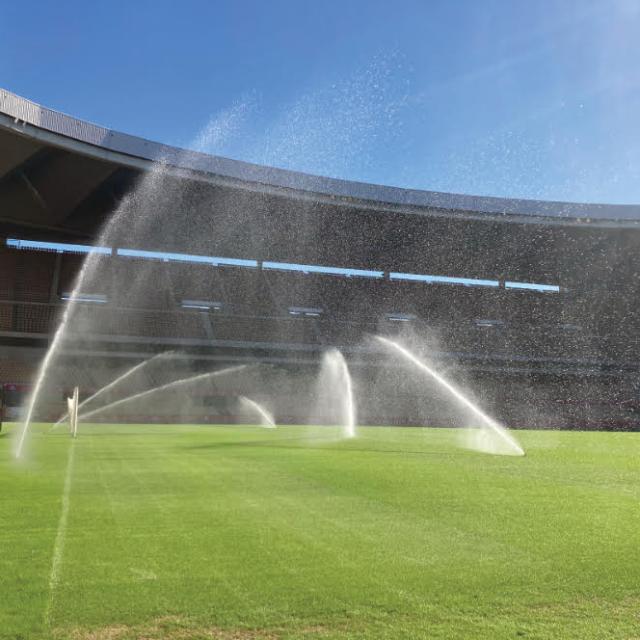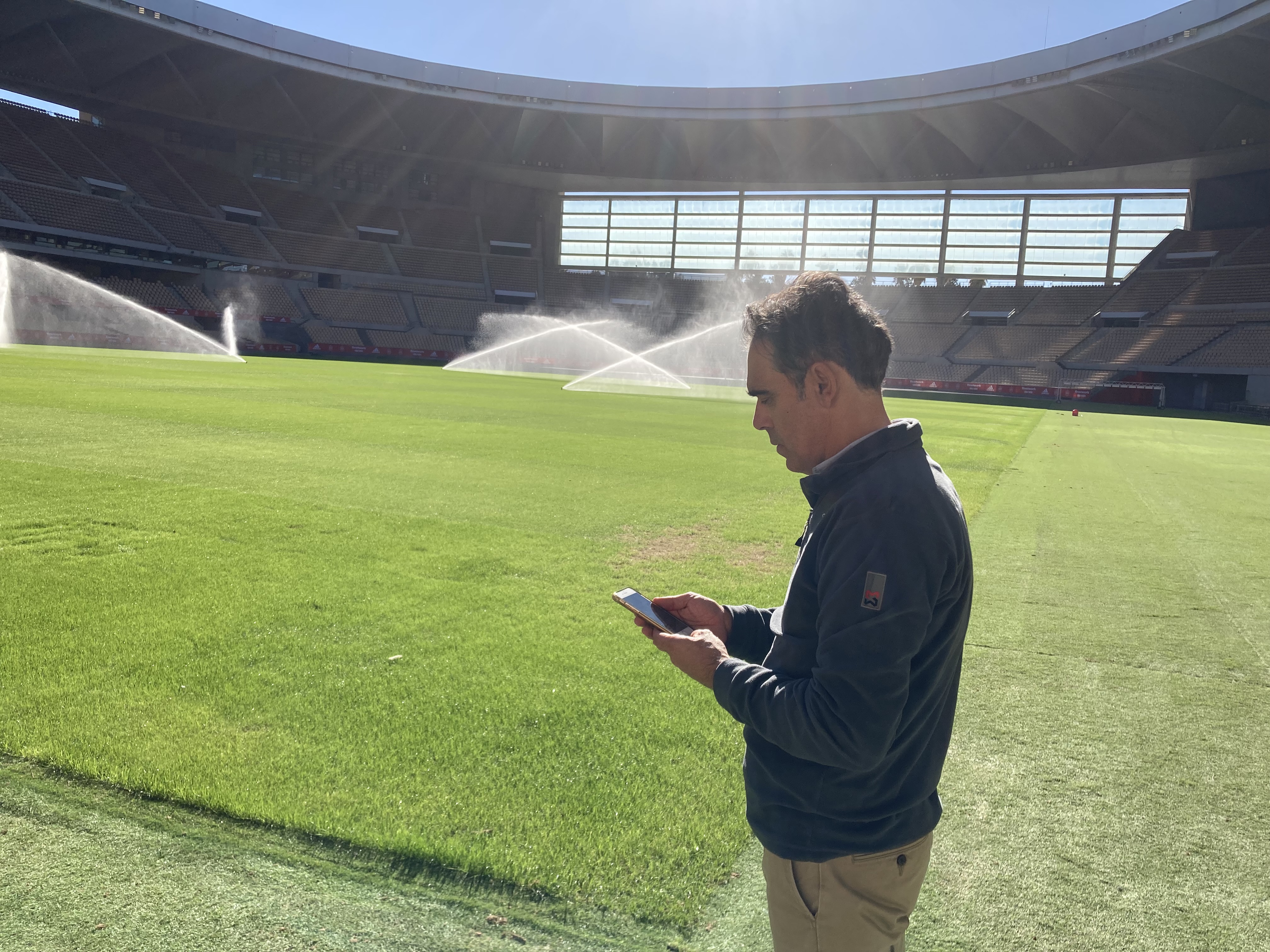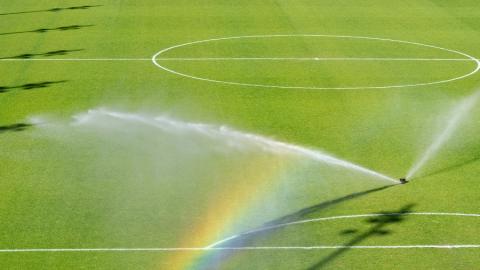I travelled to the Cartuja stadium in the company of Santiago Casanella and Gonzalo Varela González, respectively Director General and Field Service Manager in Europe at Hunter Europe.
The National Stadium is situated in the North-west of the city, in the district of Cartuja.

Designed by the architects Antonio Cruz Villalón and Antonio Ortiz García, it was inaugurated on 5th May 1999 for the World Athletics Championships. The cost of constructing this sports facility was 120 million euros and it was designed to comply with the criteria of the International Olympic Committee, so that it could host the 2004 Olympic Games.
The building of the stadium was considered to be unnecessary by some people as the city of Seville already has two stadia hosting La Liga matches, the Benito-Villamarín stadium and the Ramón Sánchez Pizjuán stadium, being home to the football teams Real Betis and Sevilla FC.
“The Cartuja stadium is not home to any one club in particular. It hosts sporting events and fixtures: for example, it was the venue for the 2002-2003 UEFA Cup Final, the 2004 Davis Cup Final, the 2021 Spanish Super Cup Final (Football)…”, explained Mr. Francisco José Carvajal, the stadium’s greenkeeper. It also hosted a number of festivals during the summer.
Some of the major Football Clubs come here to train, such as Olympique Marseille, Real Madrid, etc.
In 2020, the stadium was a host venue for Euro 2020. Since then, it has had to meet certain criteria in relation to quality and efficiency.
Major works were undertaken in 2021, including the upgrade of the pitch irrigation system, with a view to complying with the requirements laid down by FIFA and being able to host international matches.
The irrigation system was completely renovated two years ago
The stadium has a capacity of 57,619 spectators.
It has a grass playing area of 120 × 72 metres, Sportflex synthetic athletics tracks, two long jump tracks and four long and triple jump pits.
It also has more than 30,000 m2 of commercial space, including a restaurant and an hotel, a school and a medical centre, which are currently under lease.
Jose Maria Martin from the company Goymar Proyectos e Instalaciones, S.L. renovated the system that irrigates the playing area.
The old installation consisted of 35 Rain Bird sprinklers and 7 (solenoid) valves, i.e. one valve for 5 sprinklers.

Gonzalo Varela González, Hunter European field service manager, José Maria Martin Rico, Goymar (installer),
Francisco José Carvajal Almansa, Estadio Cartuja (green keeper), Santiago Casanella,Hunter Europe General Manager
The old installation have been replaced with 35 Hunter PGV-101-G-B 1” valves and 20 Hunter I-50-06-SS-B Part circle sprinklers for the side & goal lines and 15 Hunter
I-50-06-SS-ON-B Full circle sprinklers inside the pitch, each sprinkler having the possibility to be activated individually.
The new installation forms a perfect rectangle, 7 lines of 5 sprinklers, placed every 18 metres. The valve boxes and the decoders are all positioned along the same side of the pitch (5 valves in each box) so as not to interfere with the television cameras. All sprinklers have a Turf cup for maintenance.
“This new installation allows us to carry out a more precise customised irrigation, the sprinklers all operating independently of each other”, explained Mr. Gonzalo Varela González, from the company Hunter.
This is very useful, bearing in mind the demands of the teams. “For example, one day prior to an important match, the trainer can ask me to irrigate a little more in a corner”, explained Mr. Carvajal, the greenkeeper. And he adds: “That is possible with the new system”.
Furthermore, the new system has the advantage of being able to activate nearly all the sprinklers at the same time (central and peripheral sprinklers). When a team leaves the field, for example, during Euro 2020, the greenkeeper only has 5 minutes to irrigate the whole playing area. That simply was not possible with the old system.
The stadium is equipped with a Hunter Centralus central control system and a Hunter ACC2 decoder controller. This enables the user to irrigate remotely, from his or her mobile phone (cell phone).

According to Mr. Carvajal, “The new installation, apart from allowing us to meet FIFA’s criteria and host international matches, has enabled us to make a 30% saving on water.”
Water resource – pump room
The water used to irrigate the stadium is a mixture of rainwater, water pumped from a tributary of the River Guadalquivir and groundwater. This is collected in a large tank, treated and injected into the irrigation system.
We went inside the pump room where the tank is housed. The pumping station is also located there and a cabinet with a device for detecting the presence of salmonella and E. Coli.
Pump station capacity is 55 m³/h at 7,5 bar. From the pump station, there is a Ø125 mm pipe feeding a Ø110 mm loop around the pitch where the 7 valve boxes with 5 valves each are located.
“Water is always available in sufficient quantities and we are never short”, explained Mr. Carvajal.
Moreover, during the summer months, the stadium is only used for concerts. No football matches are played. The turf is allowed to dry up and it is replanted in September. The turf consists of natural grass, Ryegrass, and it costs 100,000 € each year to replace (compared with 400,000 € for a hybrid grass). The greenkeeper explains “in this case, a natural grass is sufficient because the stadium is not used intensively. That enables us to make significant savings”.
Given the location of the stadium, between the River Guadalquivir and its tributary, the grass is particularly susceptible to bacterial contamination. The greenkeeper works seven days a week, looking out, in particular, for the presence of bacteria and pathogens, because “if there should be a problem, it has to be dealt with immediately and not wait until Monday morning”.
We then left the service room and headed for the magnificent changing rooms, which are brand new and painted red. There are meeting rooms, players’ changing rooms, referees’ changing rooms and staff changing rooms. It is all extremely luxurious and very well-equipped.
The stadium is ready to host the 2030 World Cup. All that remains is to increase the seating capacity because it should be able to accommodate 70,000 spectators!

